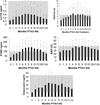PTH(1-84) administration reverses abnormal bone-remodeling dynamics and structure in hypoparathyroidism
- PMID: 21735476
- PMCID: PMC4019384
- DOI: 10.1002/jbmr.452
PTH(1-84) administration reverses abnormal bone-remodeling dynamics and structure in hypoparathyroidism
Abstract
Hypoparathyroidism is associated with abnormal structural and dynamic skeletal properties. We hypothesized that parathyroid hormone(1-84) [PTH(1-84)] treatment would restore skeletal properties toward normal in hypoparathyroidism. Sixty-four subjects with hypoparathyroidism were treated with PTH(1-84) for 2 years. All subjects underwent histomorphometric assessment with percutaneous iliac crest bone biopsies. Biopsies were performed at baseline and at 1 or 2 years. Another group of subjects had a single biopsy at 3 months, having received tetracycline before beginning PTH(1-84) and prior to the biopsy (quadruple-label protocol). Measurement of biochemical bone turnover markers was performed. Structural changes after PTH(1-84) included reduced trabecular width (144 ± 34 µm to 128 ± 34 µm, p = 0.03) and increases in trabecular number (1.74 ± 0.34/mm to 2.07 ± 0.50/mm, p = 0.02) at 2 years. Cortical porosity increased at 2 years (7.4% ± 3.2% to 9.2% ± 2.4%, p = 0.03). Histomorphometrically measured dynamic parameters, including mineralizing surface, increased significantly at 3 months, peaking at 1 year (0.7% ± 0.6% to 7.1% ± 6.0%, p = 0.001) and persisting at 2 years. Biochemical measurements of bone turnover increased significantly, peaking at 5 to 9 months of therapy and persisting for 24 months. It is concluded that PTH(1-84) treatment of hypoparathyroidism is associated with increases in histomorphometric and biochemical indices of skeletal dynamics. Structural changes are consistent with an increased remodeling rate in both trabecular and cortical compartments with tunneling resorption in the former. These changes suggest that PTH(1-84) improves abnormal skeletal properties in hypoparathyroidism and restores bone metabolism toward normal euparathyroid levels.
Copyright © 2011 American Society for Bone and Mineral Research.
Conflict of interest statement
All the other authors state that they have no conflicts of interest.
Figures



References
-
- Mayer A, Ploix C, Orgiazzi J, Desbos A, Moreira A, Vidal H, Monier JC, Bienvenu J, Fabien N. Calcium-sensing receptor autoantibodies are relevant markers of acquired hypoparathyroidism. J Clin Endocrinol Metab. 2004;89:4484–4488. - PubMed
-
- Ahonen P, Myllarniemi S, Sipila I, Perheentupa J. Clinical variation of autoimmune polyendocrinopathy-candidiasis-ectodermal dystrophy (APECED) in a series of 68 patients. N Engl J Med. 1990;322:1829–1836. - PubMed
-
- Neufield R, Maclaren N, Blizzard R. Two types of autoimmune Addison’s disease associated with different polyglandular autoimmune syndromes. Medicine. 1981;60:355. - PubMed
-
- Kao PC, van Heerden JA, Grant CS, Klee GG, Khosla S. Clinical performance of parathyroid hormone immunometric assays. Mayo Clin Proc. 1992;67:637–645. - PubMed
-
- Michelangeli VP, Heyma P, Colman PG, Ebeling PR. Evaluation of a new, rapid and automated immunochemiluminometric assay for the measurement of serum intact parathyroid hormone. Ann Clin Biochem. 1997;34(Pt 1):97–103. - PubMed
Publication types
MeSH terms
Substances
Grants and funding
LinkOut - more resources
Full Text Sources
Medical

